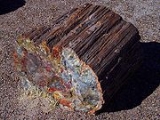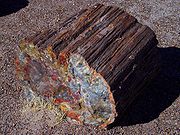
Fossil wood
Encyclopedia

Wood
Wood is a hard, fibrous tissue found in many trees. It has been used for hundreds of thousands of years for both fuel and as a construction material. It is an organic material, a natural composite of cellulose fibers embedded in a matrix of lignin which resists compression...
that is preserved in the fossil record. Over time the wood will usually be the part of a plant that is best preserved (and most easily found). Fossil wood may or may not be petrified
Petrified wood
Petrified wood is the name given to a special type of fossilized remains of terrestrial vegetation. It is the result of a tree having turned completely into stone by the process of permineralization...
.
The study of fossil wood is sometimes called palaeoxylology
Palaeoxylology
Palaeoxylology is the study of fossil wood. In the fossil record, wood is more often and better preserved than any other plant parts. Fossil wood may be petrified, but this is not necessarily the case....
, with a "palaeoxylologist" somebody who studies fossil wood.
The fossil wood may be the only part of the plant that has been preserved, with the rest of the plant completely unknown: therefore such wood may get a special kind of botanical name
Botanical name
A botanical name is a formal scientific name conforming to the International Code of Botanical Nomenclature and, if it concerns a plant cultigen, the additional cultivar and/or Group epithets must conform to the International Code of Nomenclature for Cultivated Plants...
. This will usually include "xylon" and a term indicating its presumed affinity, such as Araucarioxylon
Araucarioxylon arizonicum
Araucarioxylon arizonicum is an extinct species of conifer that is the state fossil of Arizona. The species is known from massive tree trunks that weather out of the Chinle Formation in desert badlands of northern Arizona and adjacent New Mexico, most notably in the Petrified Forest National Park...
(wood of Araucaria
Araucaria
Araucaria is a genus of evergreen coniferous trees in the family Araucariaceae. There are 19 extant species in the genus, with a highly disjunct distribution in New Caledonia , Norfolk Island, eastern Australia, New Guinea, Argentina, Chile, and southern Brazil.-Description:Araucaria are mainly...
or some related genus), Palmoxylon (wood of an indeterminate palm
Arecaceae
Arecaceae or Palmae , are a family of flowering plants, the only family in the monocot order Arecales. There are roughly 202 currently known genera with around 2600 species, most of which are restricted to tropical, subtropical, and warm temperate climates...
), or Castanoxylon (wood of an indeterminate chinkapin
Castanopsis
Castanopsis is a genus of evergreen trees belonging to the beech family, Fagaceae. The genus contains about 120 species, which are today restricted to tropical and subtropical eastern Asia. A total of 58 species are native to China, with 30 endemic; the other species occur further south, through...
).
Petrified wood
Petrified wood are fossils of wood that have turned to stone through the process of permineralizationPermineralization
Permineralization is a process of fossilization in which mineral deposits form internal casts of organisms. Carried by water, these minerals fill the spaces within organic tissue...
. All organic materials are replaced with minerals while maintaining the original structure of the wood.
The most notable example is the petrified forest
Petrified Forest National Park
Petrified Forest National Park is a United States national park in Navajo and Apache counties in northeastern Arizona. The park's headquarters are about east of Holbrook along Interstate 40 , which parallels a railroad line, the Puerco River, and historic U.S. Route 66, all crossing the park...
in Arizona
Arizona
Arizona ; is a state located in the southwestern region of the United States. It is also part of the western United States and the mountain west. The capital and largest city is Phoenix...
.
Mummified wood
Mummified wood are fossils of wood that have not permineralizedPermineralization
Permineralization is a process of fossilization in which mineral deposits form internal casts of organisms. Carried by water, these minerals fill the spaces within organic tissue...
. They are formed when trees are buried rapidly in dry or cold environments. They are valued in paleobotany because they retain original cells and tissues capable of being examined with the same techniques used with extant plants in dendrology
Dendrology
Dendrology or xylology is the science and study of wooded plants . There is no sharp boundary between plant taxonomy and dendrology. However, woody plants not only belong to many different plant families, but these families may be made up of both woody and non-woody members. Some families include...
.
Notable examples include the mummified forests in Ellesmere Island
Ellesmere Island
Ellesmere Island is part of the Qikiqtaaluk Region of the Canadian territory of Nunavut. Lying within the Canadian Arctic Archipelago, it is considered part of the Queen Elizabeth Islands, with Cape Columbia being the most northerly point of land in Canada...
and Axel Heiberg Island
Axel Heiberg Island
Axel Heiberg Island is an island in the Qikiqtaaluk Region, Nunavut, Canada. Located in the Arctic Ocean, it is the 31st largest island in the world and Canada's seventh largest island. According to Statistics Canada, it has an area of ....
.

